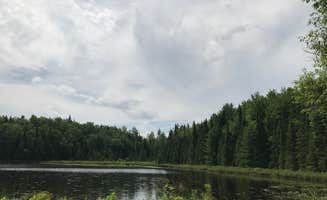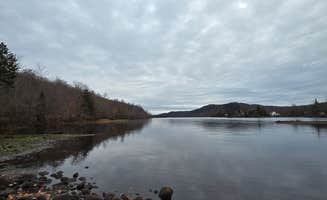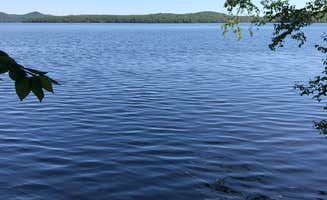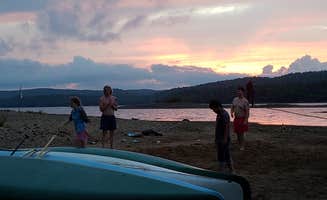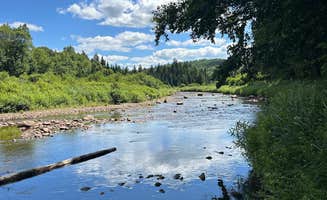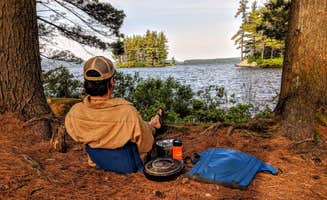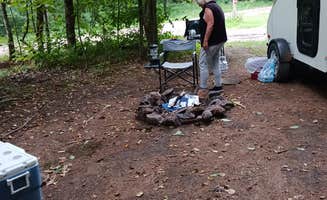Dispersed camping near Old Forge, New York offers primitive backcountry experiences throughout the western Adirondacks. The region sits at elevations ranging from 1,700 to 2,300 feet, creating a climate that averages 46°F annually with summer highs rarely exceeding 80°F. Many sites require navigation across unmarked forest roads that become impassable during spring thaw or after heavy rainfall.
What to do
Paddling exploration: At Cranberry Lake Backcountry Sites, campers can paddle to island campsites for complete privacy. "We spent 3 nights backcountry camping on Catamount Island in Cranberry Lake and absolutely loved it! The sunsets from the island were truly incredible," writes reviewer Shari G., who adds that "there are a few hiking trails where you can land your boat and hike for a few hours."
Swimming access: North Lake Reservoir Campground offers 32 lakefront sites with direct water access. "Very remote and secluded. We got there after dark and it was beautiful to wake up to the view of the lake," notes camper Ashlee C. The pristine lake provides swimming opportunities during summer months when water temperatures reach their warmest.
Fishing options: Many primitive sites include direct fishing access from shore. "Sunday lake has always been lovely and quiet and a great place to take youth campers," reports Elizabeth B. about the small but productive fishing waters. Local species include bass, pike, and various panfish depending on the specific lake or reservoir.
What campers like
Privacy and seclusion: At Powley Road in Ferris Wild Forest, campers appreciate the remote settings. "Site 4 is magical, it is road side, but the view, and access to the river is great. There is a path right from the site," reports The L., who appreciates the relative isolation despite occasional traffic.
River sounds: The natural soundtrack of flowing water enhances many sites. "There was a fire ring and access to the river down a semi-steep bank. Beautiful to listen to at night," writes Josie W. about Cod Pond Dispersed Pull-Off. Many campers mention falling asleep to the sound of nearby water features.
Wildlife viewing: The remote settings provide excellent wildlife viewing opportunities. "We saw Bald Eagles and Loons, enjoyed swimming, canoing and paddleboarding with the family," writes Christie M. about their experience camping in the region. Morning and evening hours offer the best wildlife observation times.
What you should know
Cell service limitations: Most areas have no connectivity whatsoever. "There is zero Verizon cell service in the whole area. So plan accordingly," warns The L. about Powley Road, while Meghan B. confirms "No AT&T cell service in this area." Download offline maps before arrival.
Road conditions: Access roads require appropriate vehicles in most cases. "A 20 mile ride of just woods on a bumpy road," describes Dane P. about reaching Stillwater Reservoir. Many campers recommend high-clearance vehicles for accessing the more remote sites.
Water sources: Plan to bring or filter all drinking water. "You will either need to bring your own potable water or filter from the lake, so don't forget your water filter," advises Shari G. about backcountry camping. Most campsites have nearby water sources but require proper filtration.
Tips for camping with families
Accessible options: Look for drive-up sites if camping with small children. "We kayaked to Long Island and stayed for a weekend. It was quiet and had the whole island to our self," notes Sam T., contrasting with the single drive-up site at Stillwater that's "right down the road from the fire tower trail."
Bug preparation: Insect protection is essential, especially during peak summer months. "The bugs were terrible," reports Taylor A. about their Adirondack camping experience, while another camper notes, "The mosquitoes weren't bad at the campsite itself or while kayaking, they are terrible on the trails this time of year; so bring your bug spray."
Supply planning: Stock up on supplies before heading to remote sites. J B. from North Lake Reservoir recommends: "Make sure to take a left at the start of the lake, the right is all private road and you will have to turn around." Limited resupply options exist once at camp.
Tips from RVers
Site selection: Most dispersed camping areas near Old Forge have limited options for larger vehicles. "A car is not recommended. Possible to turn around but you definitely need a smaller suv," advises Taylor A. about accessing certain campsites. Sites at Horseshoe Lake provide more parking space.
Power considerations: Solar setups may not function optimally due to forest cover. "As it's a forest, the sites are pretty shaded, so solar and Starlink may present challenges," reports Rebecca B. about camping at Horseshoe Lake, where the 10-11 designated sites have limited sun exposure.
Turnaround space: Many primitive sites lack adequate turning radius for larger vehicles. "Site was big enough to pull our mid-size SUV down and unfold rooftop-tent, but we did have to back out in the morning; not enough room to turn around," notes Josie W. about her experience at a forest road pull-off site.


